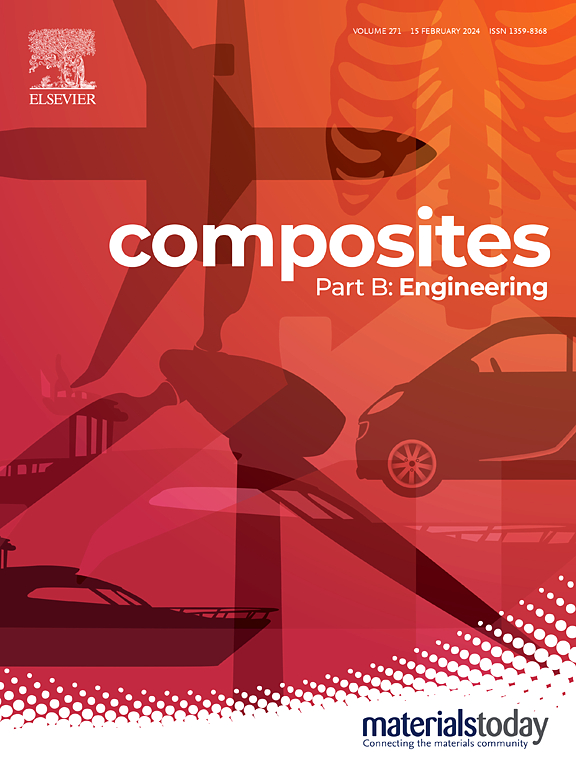Braid-trusion of hollow thermoplastic composites using an expanding mandrel approach
IF 12.7
1区 材料科学
Q1 ENGINEERING, MULTIDISCIPLINARY
引用次数: 0
Abstract
Braid-trusion involves the combination of a braiding machine with a pultrusion line to continuously produce composite structures with a constant cross-section and angle-oriented fibres. During the braid-trusion process, braids are subjected to tension and compression, which leads to braid deformation and fibre orientation variations. Successful braid-trusion of tubular structures requires a braid design methodology that accounts for braid deformations during its passage in the pultrusion die. Here, we present a braid design methodology for square hollow pultruded beams reinforced by triaxial braids. It is proposed that the internal perimeter of the braid, constrained by the braiding and pultrusion mandrels, must expand during pultrusion to account for braid consolidation. Two braid designs are proposed. The first has a constant braiding and pultrusion mandrel perimeter. The second has a braiding mandrel perimeter that is 0.9 times that of the pultrusion mandrel, referred to as the expanding mandrel approach. The design demonstrated the effect of an expanding mandrel in reducing fibre waviness by achieving similar braiding yarn lengths. Glass fibre/polyethylene terephthalate composites were pultruded with the constant and expanding mandrels. The constant mandrel braid-trusion failed while the expanding mandrel succeeded.
利用膨胀芯棒方法对中空热塑性复合材料进行编织挤压
编织挤丝是指将编织机与拉挤线相结合,连续生产具有恒定截面和有角度取向纤维的复合材料结构。在编织挤压过程中,编织体受到拉伸和压缩,导致编织体变形和纤维取向变化。成功的管状结构的编织挤压需要一种编织设计方法,该方法考虑了编织在拉挤模具中通过时的变形。在这里,我们提出了一种用三轴编织增强的方形空心拉挤梁的编织设计方法。提出在编织和拉挤芯芯的约束下,编织的内周长在拉挤过程中必须扩大,以解释编织的固结。提出了两种编织设计。第一种具有恒定的编织和拉挤芯轴周长。第二种编织芯轴周长是拉挤芯轴周长的0.9倍,称为扩展芯轴方法。该设计展示了扩大芯棒的效果,在减少纤维的波浪度,达到相似的编织纱长度。对玻璃纤维/聚对苯二甲酸乙二醇酯复合材料进行了恒膨胀芯轴挤压。恒定芯轴编织挤压失败,膨胀芯轴成功。
本文章由计算机程序翻译,如有差异,请以英文原文为准。
求助全文
约1分钟内获得全文
求助全文
来源期刊

Composites Part B: Engineering
工程技术-材料科学:复合
CiteScore
24.40
自引率
11.50%
发文量
784
审稿时长
21 days
期刊介绍:
Composites Part B: Engineering is a journal that publishes impactful research of high quality on composite materials. This research is supported by fundamental mechanics and materials science and engineering approaches. The targeted research can cover a wide range of length scales, ranging from nano to micro and meso, and even to the full product and structure level. The journal specifically focuses on engineering applications that involve high performance composites. These applications can range from low volume and high cost to high volume and low cost composite development.
The main goal of the journal is to provide a platform for the prompt publication of original and high quality research. The emphasis is on design, development, modeling, validation, and manufacturing of engineering details and concepts. The journal welcomes both basic research papers and proposals for review articles. Authors are encouraged to address challenges across various application areas. These areas include, but are not limited to, aerospace, automotive, and other surface transportation. The journal also covers energy-related applications, with a focus on renewable energy. Other application areas include infrastructure, off-shore and maritime projects, health care technology, and recreational products.
 求助内容:
求助内容: 应助结果提醒方式:
应助结果提醒方式:


